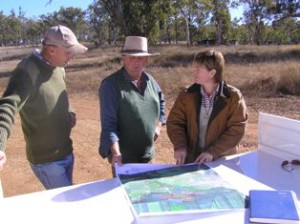Best management practice (BMP)
February 13th, 2015
 We work hard to stretch our precious time and budgets to support our operations. Yet there’s always more to be done.
We work hard to stretch our precious time and budgets to support our operations. Yet there’s always more to be done.
When it comes to weeds, pests and diseases, it’s a seemingly never-ending cycle… Weeds need to be treated and follow-up completed; fence lines, roads and other infrastructure protected; and pests deterred. But what if we could get on top of things for a change?
The most effective management solutions rely on using accurate information to inform sound planning and implementation. A proactive approach to weed, pest and disease management employs best management practices to help:
- save time and money on infrastructure maintenance;
- maintain access to all areas within your site / property;
- foster better relationships with stakeholders and local landowners; and
- ensure your site / property operates at optimal capacity.
So how do you implement best management practices as part of your operations?
Know your land
To prevent the establishment and spread of weeds and pests, you need to know your land. You can gain valuable information from regular surveys and monitoring. Good areas to focus on include waterways, entry, exit routes, internal roads or tracks, disturbed areas, livestock feeding or rest points and sites adjacent to known weed and pest infestations. Your survey frequency can be adjusted depending on the type of property, core activities, seasonal conditions, risks and any specific compliance requirements you may have.
By documenting the extent, abundance and density of existing biosecurity issues over the life of a project or regularly on a property over the years, you’ll be able to readily identify new and emerging threats or incursions and respond accordingly. Useful tools include GPS records, mapping and photo monitoring sites. You’ll find that the biggest benefits come from consistent monitoring approaches that are taken over time and not just at the start of a project or at property purchase.
Know what you need to achieve and why
It’s important to have a good understanding of how weeds and pests might impact on your operations. Weeds and pests can degrade your capability, damage your company’s reputation and require years of costly control, follow-up and monitoring. Should a significant incursion occur, there is also the risk of potential litigation and compensation claims.
To protect and maintain your operations, you need to understand the risks that weeds and pests present. From there, you can get to know your local pest and weed issues and understand your current weed and pest liability on your site or property. Using this information, you can then set appropriate goals to guide your future management actions from prevention through to control, reduction and eradication.
Prevent and detect pest infestations
Prevention is your first line of defence and generally your cheapest. Weeds, pests and diseases often spread through contaminated vehicles, machinery, loads and other vectors. It’s therefore important to minimise the opportunity for new weeds and pests to move into an area whilst also restricting the spread of any existing infestations.
Early detection gives you the chance to control weeds and pests before they become a serious problem. And controlling one weed is certainly a lot easier and cheaper than trying to address a whole paddock full of weeds down the track.
Successfully identifying and controlling weed and pest outbreaks requires everyone’s commitment. It can be helpful to raise awareness of your staff and visitors through signage, information handouts or forums such as your toolbox meetings and site inductions. You can also improve awareness by developing handouts of weed and pest issues for your site that includes a photo and basic ID explanation. Simple reporting procedures can also help to capture sightings and promote a proactive weed detection and reporting culture.
Plan and implement your approach
To ensure that your control resources are used wisely, all pests should be accurately identified at the time of detection. There are a range of handy weed and pest ID resources available or you can contact your local Council Weeds Officer, State Biosecurity Officer or specialist weed advisor.
It’s then important to get the most out of your time and money by developing a sound plan of attack. Some weeds and pests may only require monitoring and containment at your site, whilst others may require considerable investment over time.
Your plan should determine the best control method for your situation. You will need to consider issues such as site access, resources, timing, seasonal influences, adjacent land uses and activities and other associated risks. This can help you to comply with legislative requirements and coordinate control activities with other property activities and your neighbours. It can also improve the efficiency of your control activities by ensuring they are prioritised and appropriately timed.
Consider the full range of options available to control the weed or pest including physical, mechanical, chemical, biological, fire, grazing and other control strategies. Depending on your specific site requirements, a combination of these strategies is often found to be the most effective.
What risks do weeds, pests and diseases pose to your operations from a safety, environmental, capability, financial, legal or reputation perspective? How could a combination of best management practices help you to get on top of your weed and pest issues?